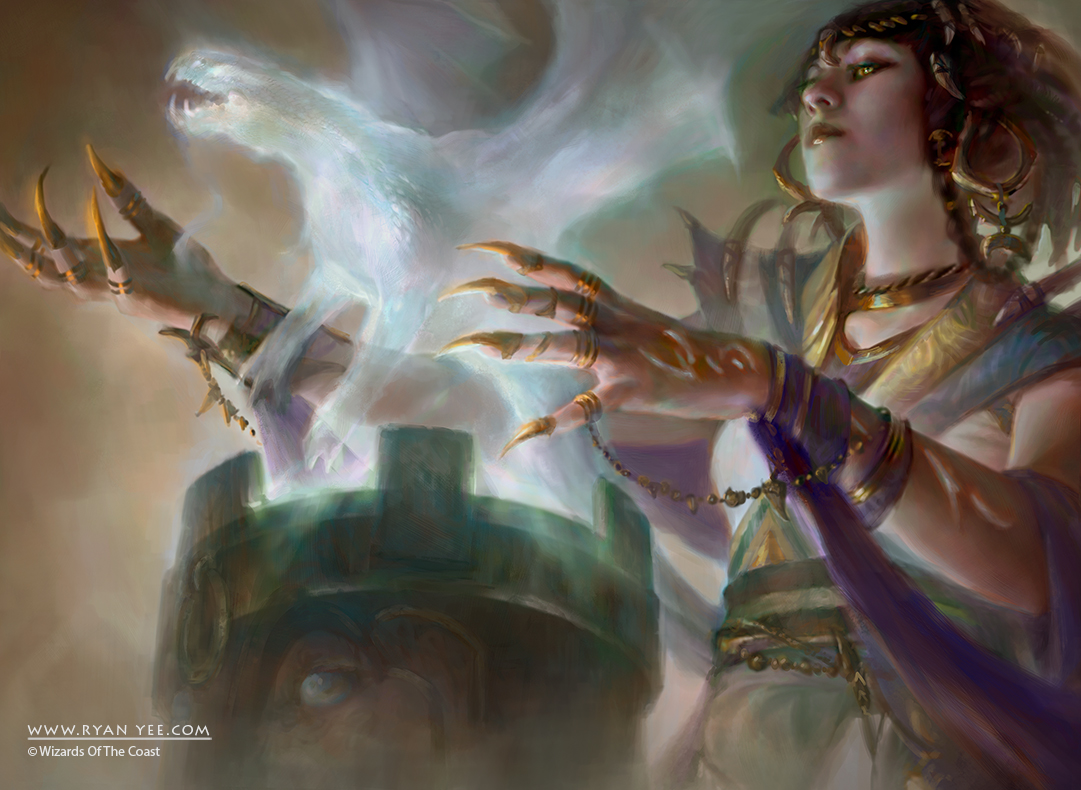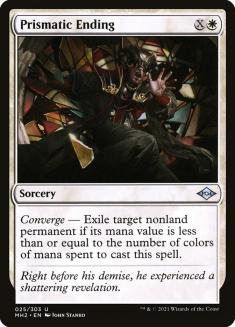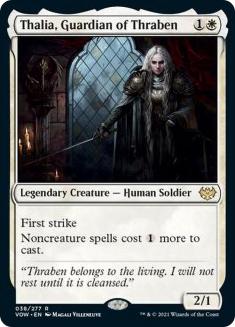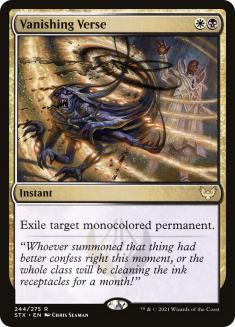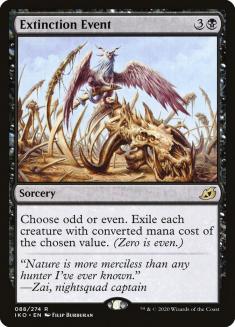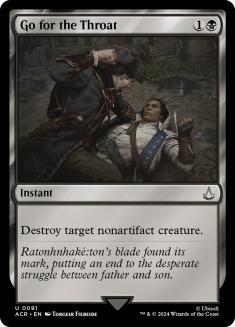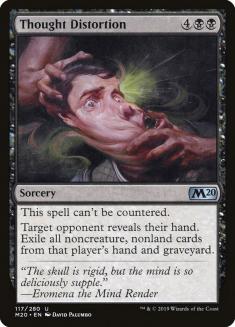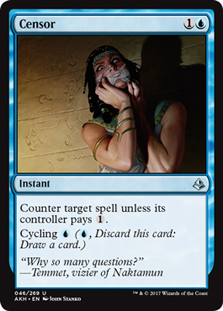I have been on the Azorius Control train for a long time. This devotion to Supreme Verdict extends past Pioneer and into Modern. In my old age, it seems I have become more risk-averse. Adding a third color is a gamble, even in a format with strong mana, such as Modern. The more colors, the more tapped and/or shocklands, putting a strain on the control user. This negatively affects life total or curve speed, a detriment I have avoided for the last few years. The white removal being produced has uplifted Azorius Control to a level where black can be left aside, but the metagame in Pioneer has adapted.
In Pioneer, Azorius Control does not have access to Prismatic Ending. The absence of this powerhouse removal spell hits home, even with the addition of Lay Down Arms. When I give Azorius Control a try again in Pioneer, you’d better believe my manabase will accommodate that removal spell. Lay Down Arms has a comparable effect to Prismatic Ending; however, it does not get there against noncreature targets. Adding black frees control decks in Pioneer from a struggle when difficult threats resolve.
It is time to take the plunge back into Esper Control, an archetype that is near and dear to my heart. Beyond the personalized ESPER license plate, my strongest tournament was made possible by the power of Esper Control. I played the same color combination in all formats, leaning on the effectiveness of blue disruption, white sweepers, and black targeted removal. That formula has not changed, even with the increase in white’s removal capacity. Black removal is still the best by far, and I am going to gamble on the higher-risk manabase.
Two Recent Lists
Planeswalkers (6)
Lands (26)
Spells (28)

Creatures (1)
Planeswalkers (6)
Lands (25)
Spells (28)

The lists above come from a recent Pioneer League, where each player finished 5-0. There is a lot to like about each option, especially in a format with this many decks that have competitive potential. Pioneer was relegated to a format with two or three options before the recent Regional Championships. There are far more decks that can take down championships, with Mono-White Humans being one of the first surprises.
Mono-White Humans had little traction before taking down the Regional Championship in Atlanta, but now it is one of the most-played decks. It is a fast deck that constantly annoys me with Thalia, Guardian of Thraben. Even with that ace in the hole, it is still a very good matchup for most control configurations. When piloting Azorius Control, there are draws that have no chance against a strong Mono-White Aggro start; however, that scenario is much less likely when playing Esper Control. Leaning too heavily on the sweepers to bail you out when a Thalia is present is a losing proposition, one that occurs less frequently with black removal available.
Each Esper Control list featured capitalizes on black removal, creating a unified front behind Fatal Push. The recent removal printings made many control enthusiasts forget how good this card was. The downside is having very few ways to cast it Turn 1, the same challenge that makes Thoughtseize a difficult card to play in Pioneer control decks. Although Fatal Push is helpful Turn 1, it holds value for the majority of the game against most matchups.
Vanishing Verse is another universal card for Esper Control in Pioneer and helps to rectify the noncreature problem in this format. Lay Down Arms cannot compare to Vanishing Verse, as the latter hits most resolved threats at instant-speed in the format. One of the most frustrating things I ran into while playing Azorius Control is its difficulty in dealing with enemy planeswalkers. I tried a variety of mediocre options, usually as a one or two-of, but nothing as good as Vanishing Verse. Void Rend is another option that Esper brings, but the additional mana makes it much less appealing. I see it in the first list’s sideboard, a move that I agree with.
I would not consider the other black cards in these lists must-play staples. I am personally not in love with Extinction Event, even though I respect the exile effort. There are too many situations in Pioneer where a battlefield is cluttered by odd and even creatures, making that sweeper a liability. I prefer to use Farewell for that effect, even with the additional mana requirement. Supreme Verdict is still the best option we have in the sweeper department and should be at least a three-of in control main decks.
Go for the Throat is a strong addition, and I would likely use it to supplement my other removal spells like the first list does. Fatal Push needs some backup as the game progresses and there are very few artifact creatures running around. I have always been a fan of Go for the Throat, even in metagames that have immune options. Regardless of how strong artifact-based decks are, there are always targets for this removal spell. In Pioneer, it can kill almost anything that the opponent summons for just two mana.
Both sideboards have black disruption spells to make ground against the combo and other slow decks of the format. Thoughtseize is the obvious option that comes in against a variety of decks. The chunkiness of black mana makes it a sideboard card; however, it is still a very powerful effect. It would be difficult for me to play a different hand disruption spell without first employing this timeless resource. The common practice for control is to bring in a bunch of cheap counterspells and deal with those matchups in that fashion. Thoughtseize plays a similar role, but is proactive, cheaper, and more effective in most scenarios.
The other black disruption spells in these two lists are Thought Distortion and Unmoored Ego. Thought Distortion is the bee’s knees against the slower matchups, especially if they hope to stop you with a Dovin’s Veto of their own. This is the ultimate haymaker against the mirror that cannot be stopped by traditional means. If the opponent plays around this card, they drop their expensive planeswalkers into open mana for the easy counterspell. This allows us to land our permanent without fear of disruption. Cards like this can win the mirror on its own, so I will also have one in my Esper Control sideboard.
Return of the King?
Looking at these winning lists has given me the inspiration I needed to make my own version of Esper Control. Both these lists have their pros and cons, but neither gambles on the underplayed cards that control should begin to experiment more with. Azorius Control did not have many cheap spells, making the curve quite high. Esper Control is much better at this, which opens an opportunity for Dig Through Time to return to its former glory.
Planeswalkers (6)
Lands (26)
Spells (28)

Memory Deluge has taken center stage, separating itself from all other card draw spells in Pioneer. This is for good reason, as the card is one of the best of its type ever printed. Without fetchlands to fuel graveyards, the efficacy of Dig Through Time has been in question for years. In the early stages of Pioneer, I tried playing Esper Control with every cheap disruption spell I had access to. I won a decent amount then, firing off Dig Through Times with a Torrential Gearhulk as a follow-up. Unfortunately, the power of the format has made that combination less dynamic than it once was. Torrential Gearhulk may be washed, but I think Dig Through Time does not get tested enough in the format.
Thoughtseize is a sideboard card because of the mana, but Dig Through Time incentivizes it being in the maindeck. I am starting with this configuration, and I will see if I can cast Dig Through Time consistently without the assistance from cheap black removal during Game 1. Of the few games I have played thus far, it has not been difficult to put together. The four copies of Censor, the cheap black creature removal, and the typical gameplay of blue disruption fill the graveyard consistently by the mid-game. Adding Thoughtseize could let it happen a turn earlier than the standard Turn 5.
With the addition of Dig Through Time, we are better utilizing the power of the black splash. The cheap removal can leave us with card disadvantage, since many of the creatures we are killing leave behind some advantage for the opponent. Dig Through Time has always been a great reward for tossing your hand at the opponent in the early-game. Choosing the best two cards in the top seven wins games, especially late. When Dig Through Time is used then, it only costs two mana and the control user can do some silly things with their remaining resources. These multi-spell turns separate it from Memory Deluge on the power level scale. The only catch is the sideboarded Rest in Peace.
While playing Esper Stoneblade in Legacy, there was a brief period where Dig Through Time was legal. I made second place in an SCG Open during that time, gladly paying eight to draw some cards while a Rest in Peace was on the battlefield. Since Rest in Peace only comes in against Izzet Phoenix and Abzan Greasefang, it is worth the non-synergy to have both powerful effects in the same deck. If it is on the battlefield, we are probably crushing both decks, and if it is not, then Dig Through Time is a very cheap draw spell still. In the event Dig Through Time costs eight because of a Rest in Peace, the game is likely in a stall, and the maximum cost is still doable.
If we return to Memory Deluge, it will not be because of a sideboard enchantment. I hope we can work together to get Dig Through Time back on the map. This Esper Control list is a start.

